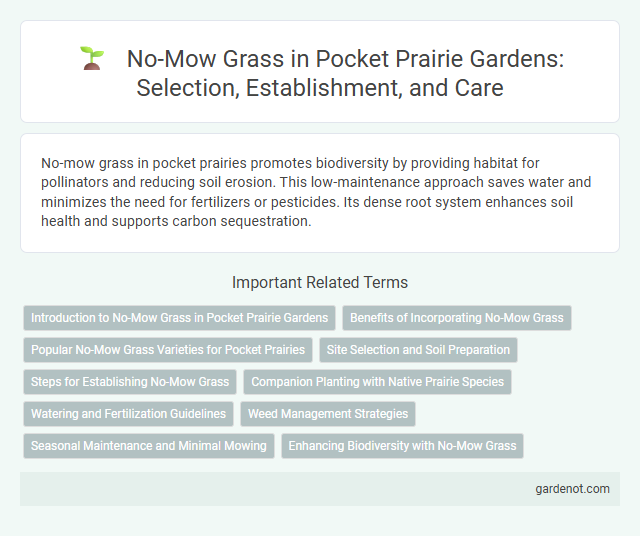No-mow grass in pocket prairies promotes biodiversity by providing habitat for pollinators and reducing soil erosion. This low-maintenance approach saves water and minimizes the need for fertilizers or pesticides. Its dense root system enhances soil health and supports carbon sequestration.
Introduction to No-Mow Grass in Pocket Prairie Gardens
No-mow grass in pocket prairie gardens offers a sustainable landscaping solution by reducing maintenance and promoting biodiversity. This low-growing, slow-spreading grass supports native pollinators and improves soil health through minimal disturbance. Incorporating no-mow grass enhances ecological balance while providing an attractive, natural lawn alternative.
Benefits of Incorporating No-Mow Grass
No-mow grass in pocket prairies significantly reduces maintenance time and costs by eliminating frequent mowing requirements. Its deep root systems improve soil health, enhance water retention, and support biodiversity by providing habitat for pollinators and beneficial insects. This sustainable landscaping choice also lowers carbon emissions and noise pollution, contributing to a healthier urban environment.
Popular No-Mow Grass Varieties for Pocket Prairies
Popular no-mow grass varieties for pocket prairies include fine fescues such as chewings fescue, hard fescue, and creeping red fescue, prized for their low-maintenance growth and drought tolerance. Buffalograss is another excellent choice, valued for its deep root system that supports soil health and requires minimal watering. These species create a natural-looking lawn alternative that reduces mowing frequency while promoting biodiversity and ecosystem resilience.
Site Selection and Soil Preparation
No-mow grass thrives in well-drained soils with moderate fertility, making site selection crucial for establishing a sustainable pocket prairie. Preparing the soil involves removing existing turf, minimizing soil disturbance, and ensuring a loose seedbed to promote deep root growth. Testing soil pH and amending it to a range of 6.0 to 7.0 enhances nutrient availability and supports healthy grass establishment.
Steps for Establishing No-Mow Grass
Establishing no-mow grass begins with selecting drought-tolerant and native grass species suited for low-maintenance growth and soil conditions. Prepare the soil by removing existing grass, loosening the soil, and applying organic amendments to improve nutrient content and drainage. Seed evenly, water consistently until established, and avoid mowing to allow the grass to develop naturally, promoting biodiversity and reducing maintenance efforts.
Companion Planting with Native Prairie Species
No-mow grass thrives in pocket prairies by pairing seamlessly with native prairie species such as little bluestem, purple coneflower, and black-eyed Susan, which enhance biodiversity and soil health. Companion planting with these native species improves pest resistance and supports pollinators like bees and butterflies, creating a balanced ecosystem. This integration reduces maintenance while promoting ecological stability and resilience in urban and suburban landscapes.
Watering and Fertilization Guidelines
No-mow grass varieties thrive with minimal watering, requiring only about one inch of water per week, ideally applied in the early morning to promote deep root growth. Fertilization should be limited to once or twice per growing season using a slow-release, nitrogen-rich fertilizer to support sustainable growth without encouraging excessive blade height. Proper watering and fertilization practices help maintain the natural ecosystem benefits of pocket prairies, such as soil health and pollinator support.
Weed Management Strategies
No-mow grass in pocket prairies requires targeted weed management strategies to maintain native plant dominance and biodiversity. Techniques such as selective hand weeding, mulching, and the use of organic herbicides help control invasive species without disrupting soil health. Integrating regular monitoring and adaptive management ensures effective suppression of weeds while promoting the growth of desired prairie flora.
Seasonal Maintenance and Minimal Mowing
No-mow grass in pocket prairies requires seasonal maintenance focused on early spring and late fall care to promote healthy growth and biodiversity. Minimal mowing, typically once or twice a year, prevents invasive species and maintains native plant dominance without disrupting wildlife habitats. This low-maintenance approach supports sustainability and conserves water while enhancing the natural ecosystem.
Enhancing Biodiversity with No-Mow Grass
No-mow grass significantly enhances biodiversity by providing habitat and food sources for pollinators, birds, and beneficial insects within pocket prairies. These grasses support native flora diversity by reducing lawn maintenance and allowing wildflowers and native plants to thrive naturally. Incorporating no-mow grass areas promotes ecological balance and strengthens local ecosystems in urban and suburban landscapes.
No-mow grass Infographic

 gardenot.com
gardenot.com